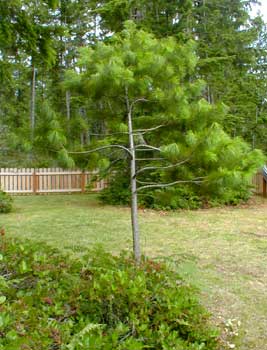
Western White Pine
"This is the forest primeval.
The murmuring pines & the hemlocks,
Bearded with moss, & in garments green,
indistinct in the twilight."
-Henry Wadsworth Longfellow
(1807-1882)
(1807-1882)
Western White Pine Pinus monticola is also known as Silver Pine or the Little Sugar Pine. It is called white or silver because of its smooth small-grained pale wood, or for a white stem that appears near the top of mature trees. It was first described & named by Scottish botanist David Douglas when he visited Mount Saint Helens in 1831.
This state tree of Idaho was once the most common tree through much of the northern Rockies, where it grew larger than populations on the west coast of British Columbia & Washington. It lives today on less than five percent of its former range, thanks to over-harvesting, assaults by the mountain pine beetle, which eradicated the entirety of many a coastal western hemlock forest, as well as lodgepole pine forests of the Central Rockies.
The final nail in the white-pine coffin was the introduction in 1910 of fungal blister rust, a fatal disease brought to the Northwest on ornamental pines from France.
In 1950 the search was on for rust-resistant survivors from which seeds could be collected & resistant strains bred. A reforestation program for white pines in southern British Columbia, western Montana, & northern Idaho was undertaken from the 1980s onward, but as the white pine takes a century to become an ideal lumber tree, & because firs & other species have already taken over forests once dominated by the white pine, restoration is not swift, certain, or easy.
An additional threat was discovered to be native currant shrubs which serve as carriers of blister rust. Areas to be repopulated with white pines have required currants to be taken out of the ecosystem.
The ultimate fate of the Western White Pine is still iffy. With the rise of conservatism & new economic policies of the Bush presidency, conditiosn became more favorable for exploitation than for preservation. Political priorities shifted away from sustainable forests, & at present, under the Obama administration, the white pine restoration project remains in low mode.
As I write this paragraph, there appears to be only slight hope of a larger "green economy" & "carbon savings" focus on national forest health under President Obama. Lip service has been the extent of it so far, so I'm not holding my breath that the US is going to be doing more for this formerly ubiquitous tree. Rather more has been supported in Canada.
There is a domino effect with the loss of such a major species. The loss of white pines, & its supplanting by the much more shallowly rooted & less fire resistant western cedars, & western hemlocks, & Douglas firs, has lent to the problem of savage forest fires & has facilitated the spread of tree pests & diseases that assault weakened forests. It's vanishing status makes white pine wood all the more valuable, which means the species continues to be logged with far too few protections.
White Pines were once very common around Puget Sound, but after blister rust arrived in the Northwest via Canada, the Puget Sound populations were by 1923 the second group to become infected. Among lumbermen it was open season on the species, since it was expected that any tree not harvested would in any case not survive. But the future of the species requires the preservation of old growth white pines & a watchguard policy of spotting rust resistant specimens from which seeds can be gathered. Much more genetic research, presently poorly funded, is essential.
Here in Kitsap County between Puget Sound & HOod Canal, the white pines are uncommon. The county is hilly but not mountainous & these pines prefer a bit of mountain height. Even so, big specimens are encountered often enough for white pines to be familiar, with some extremely nice healthy specimens in an old-growth setting in the Illahee Forest Preserve a short ways from the Garden of Paghat the Ratgirl. The largest of the Illahee white pines is thought to be the largest anywhere in Western Washington.
These trees produce long large cones with long-winged seeds. Seedlings erupt considerable distances from mature trees. The young White Pine shown in the photo above grows at the edge of several hemlocks on a good friend's acre where I've done some landscaping, careful to preserve choice naturally-occurring native shrubs & trees.
The specimen shown has most of its limb growth on the side of facing the sun; a hemlock keeps it shaded on the side with smaller limbs. A second young tree a bit larger grows in a similarly sunny location on the property line. It too has very uneven growth, as a mix of long & short limbs tends is typical of young western white pines.
White pines grow to 175 feet with trunks five to eight feet in diameter. Among the largest white pines alive today is a specimen near the Elk River in Idaho, 219 feet high. In a mountain near Medford, Oregon, is an old giant 239 feet tall.
As a garden tree there are rust-resistant cultivars available from the better nurseries, including a weeping variety. They want a full sun or a western exposure & will not take much shade. Saplings will grow two feet a year or even faster. It will tend to grow with an irregular shape.
They need a well-draining location & will probably not need to be watered except at the height of a dry summer. It is recommended not to include currant shrubs in the same landscape.